Features - July 7, 1999
Reunions '99
 This year some 7,800 alumni, the largest
recorded number ever to return for Reunions, burst upon the campus the weekend
of May 29. Counting family members, the throng totaled an estimated 15,000.
Former classmates gathered in lecture halls where they once scribbled notes,
caught up on who's doing what, and discreetly compared expanding waistlines
and receding hairlines. They dressed in all combinations of orange and black.
Women donned tiger earrings and orange scarves. Men wore tiger-skinned baseball
caps, orange-and-black striped socks, and orange ties. A new -- and controversial
-- addition to everyone's uniform were orange hospital-type wristbands to
control access to parties.
This year some 7,800 alumni, the largest
recorded number ever to return for Reunions, burst upon the campus the weekend
of May 29. Counting family members, the throng totaled an estimated 15,000.
Former classmates gathered in lecture halls where they once scribbled notes,
caught up on who's doing what, and discreetly compared expanding waistlines
and receding hairlines. They dressed in all combinations of orange and black.
Women donned tiger earrings and orange scarves. Men wore tiger-skinned baseball
caps, orange-and-black striped socks, and orange ties. A new -- and controversial
-- addition to everyone's uniform were orange hospital-type wristbands to
control access to parties.
Under bright sunny skies, alumni attended numerous activities, including
arch sings, demonstrations, receptions, tours, concerts, shows, athletic
events, and workshops. Reuners could choose from a host of seminars and
lectures on a wide range of topics, from Princeton in space to entrepreneurship
to the global economy and Latin America. Health care, education, and God
proved especially popular topics, as alumni could choose from several seminars
on each. The buzz Friday afternoon was Bill Bradley '65's appearance in
Robertson Hall  at a presentation of a video on George Washington. The
presidential hopeful made brief remarks.
at a presentation of a video on George Washington. The
presidential hopeful made brief remarks.
On Friday morning in McCosh 50, several alumni involved in academic medicine
discussed the business of health care. The new system of health care comes
down to "rationing," said William J. Ledger '54, the panel's chair
and a professor in the obstetrics and gynecology department at Cornell University
Medical College. Forty million Americans, he said, have no medical insurance.
Ledger, who called himself a "closet socialist," believes health
care is a "basic right" that must be provided. Bruce J. Hillman
'69, a professor and chairman of the Radiology-Health Sciences Center at
the University of Virginia, said that the missions of teaching hospitals
-- research, patient care, and education -- are in trouble, because reimbursements
from all payers, including managed-care organizations and Medicare, have
been cut in recent years. Managed care, he said, doesn't invest in preventive
care or in research. Consequently, academic hospitals have to become more
entrepreneurial, said Hillman.
Reflecting the nation's concern with the plight of children in the wake
of school shootings this spring, some alumni gathered in McCosh 10 to discuss
the pressures children and parents face in the late 20th century in a panel
discussion titled "Raising Our Children: Too Much, Too Soon?"
Cleveland D. Rea, Jr. '69, a therapist at the Drenk Mental Health Center
in Mt. Holly, New Jersey, captured part of the problem by quoting a teenage
patient who told him, "We don't peel carrots, we don't bake cookies
with our grandparents." Children, he said, need to be grounded in place,
family, community, and faith. According to Rea, who was home part-time when
his children were small, a parent's response to "too much, too soon,"
should be saying "no" (with respect and love) and giving of his
or her time. Several parents in the audience complained that children today
are overscheduled, running from one activity or practice to another, leaving
little time for free play. Some argued that their children received too
much homework, while others said theirs didn't get enough. A schoolteacher
deplored the pressure put on schoolchildren to earn good grades so they
will get into the "right college," land the "right job,"
and live the "right life."
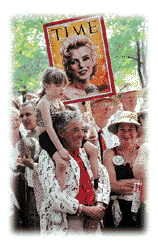 Saturday morning in McCormick 101, alumni debated whether Princeton
was a jock school. Celia A. Herron '74, who was the university's first female
diver in the early days of coeducation, said, "Yes! And we should be
darn proud of it. Diving gave me a niche." B. Peter Carry '64, the
executive editor of Sports Illustrated, worried that, due to the
high level at which Princeton's teams compete, it has to recruit an "unduly"
large percentage of every incoming class as athletes. This situation, he
said, affects the admission process and the composition of the student body.
Saturday morning in McCormick 101, alumni debated whether Princeton
was a jock school. Celia A. Herron '74, who was the university's first female
diver in the early days of coeducation, said, "Yes! And we should be
darn proud of it. Diving gave me a niche." B. Peter Carry '64, the
executive editor of Sports Illustrated, worried that, due to the
high level at which Princeton's teams compete, it has to recruit an "unduly"
large percentage of every incoming class as athletes. This situation, he
said, affects the admission process and the composition of the student body.
THE ONE AND ONLY P-RADE
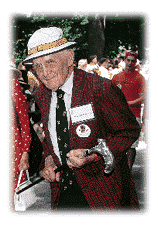 On Saturday afternoon, the Allentown High School marching band, courtesy
of the Class of 1949, snaked through the crowd in front of Nassau Hall as
musicians warmed up and alumni waited for the 2 p.m. start of the P-rade.
Many appeared slightly wilted in the heat, and some carried water bottles.
To the tune of "Going Back," the Princeton band started the procession,
followed by the 25th-reunion Class of 1974, whose theme was "Stars
in Stripes." Class members clutched silver, star-shaped balloons and
celebrated some of their more notorious activities on placards held aloft:
"popping pills, smoking joints" and "Nude Olympics begins."
Following in their wake were members of the Old Guard, led by W. Harding
Kneedler '22, who carried the Class of 1923 cane as the oldest member of
the oldest class returning to Reunions.
On Saturday afternoon, the Allentown High School marching band, courtesy
of the Class of 1949, snaked through the crowd in front of Nassau Hall as
musicians warmed up and alumni waited for the 2 p.m. start of the P-rade.
Many appeared slightly wilted in the heat, and some carried water bottles.
To the tune of "Going Back," the Princeton band started the procession,
followed by the 25th-reunion Class of 1974, whose theme was "Stars
in Stripes." Class members clutched silver, star-shaped balloons and
celebrated some of their more notorious activities on placards held aloft:
"popping pills, smoking joints" and "Nude Olympics begins."
Following in their wake were members of the Old Guard, led by W. Harding
Kneedler '22, who carried the Class of 1923 cane as the oldest member of
the oldest class returning to Reunions.
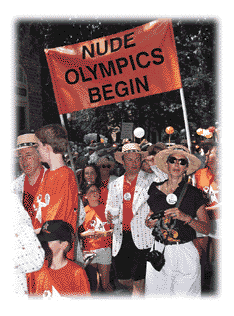 The Allentown marching band heralded the 50th-reunion Class of 1949,
which celebrated events of the century, some good ("1937 -- Golden
Gate Bridge") and some bad ("1974 -- hot pants") on numerous
placards. The 45th-reunion Class of 1954 carried Japanese lanterns and earned
loud applause for its uniform: Japanese happi coats with a growling
tiger on the back and the class numbers in Japanese characters on the lapel.
The Allentown marching band heralded the 50th-reunion Class of 1949,
which celebrated events of the century, some good ("1937 -- Golden
Gate Bridge") and some bad ("1974 -- hot pants") on numerous
placards. The 45th-reunion Class of 1954 carried Japanese lanterns and earned
loud applause for its uniform: Japanese happi coats with a growling
tiger on the back and the class numbers in Japanese characters on the lapel.
In a macabre touch, members of the 30th-reunion Class of 1969 marched
with a casket to mark the end of the millennium. To give relief from the
heat, folks on foot and atop a white firetruck sprayed spectators with water
guns. The fifth-reunion Class of 1994 must have partied too hard the night
before, as they appeared slightly under the weather as they entered the
procession. Following behind the Princeton band, members of the senior class,
the biggest in Princeton's history, ran and cheered their way to Poe Field
where Brent L. Henry '69, chair of the Alumni Council, welcomed them into
the alumni body. After the P-rade, some graduates took to the waters of
the Woodrow Wilson School fountain, while others joined a long line for
ice cream at Thomas Sweet on Nassau Street.
That evening, for the fourth year in a row, the Santore Brothers of Garden
State Fireworks presented a dazzling fireworks display. Poe-Pardee Field
was packed with alumni and friends who brought blankets, children, and dogs.
As one spectator observed, "It's like [a concert at] Central Park."
As a full moon peeked out from clouds, the explosions of colored rockets
lit up the sky. Preceding the Santores' sound and fury, the University Orchestra
inspired the crowd with the music of Beethoven, Mozart, and Cole Porter.
Post fireworks, reuners migrated back to their tents for more merriment
and catching up. The Class of 1989, which wisely provided a fenced-in play
area for kids, lost no time getting on the dance floor. As is typical, the
fifth-reunion Class of 1994 boasted the rowdiest and biggest crowd. Under
Blair Arch near the Class of 1974's tent, the Katzenjammers attracted a
big crowd for an arch sing-along.
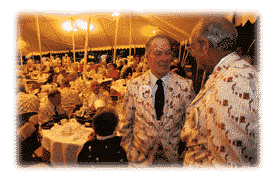 BOOGIE NIGHT
BOOGIE NIGHT
Inside the the Class of 1974's tent, its members partied hard as classmates,
spouses, and kids boogied to the tunes of "Brown-eyed Girl" and
"It's a Celebration." One member of the class paid this 34-year-old
mother/reporter a huge compliment by assuming I was covering Reunions for
The Daily Princetonian. (He then asked me to dance, but that's another
matter.) As a graduate of Georgetown University who has covered Reunions
for paw for the last five years, I am still astonished by the amazing loyalty
and spirit of the alumni who return for this annual celebration. This year,
Princetonians proved once again, that when it comes to Reunions, they do
it best.
-- Kathryn Federici Greenwood
Commencement '99
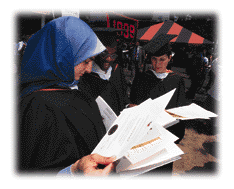 Princeton's 252nd commencement ceremony on June 1, was like no other
for two graduating seniors. Not only did Anastacia M. Rohrman receive her
B.S., but she also was asked for her hand in marriage by classics major
Thomas W. Schmidt, who near the end of his Latin salutatory address switched
into English, without missing a beat, and asked her, "Will you marry
me?" A stunned Rohrman could only cry and hold up a sign reading "Yes!"
on both sides which one of Schmidt's friends shoved into her hands.
Princeton's 252nd commencement ceremony on June 1, was like no other
for two graduating seniors. Not only did Anastacia M. Rohrman receive her
B.S., but she also was asked for her hand in marriage by classics major
Thomas W. Schmidt, who near the end of his Latin salutatory address switched
into English, without missing a beat, and asked her, "Will you marry
me?" A stunned Rohrman could only cry and hold up a sign reading "Yes!"
on both sides which one of Schmidt's friends shoved into her hands.
On a warm and sunny morning, the lovers earned two of the 1,806 bachelor
and advanced degrees that the university conferred. There were 625 men and
547 women in the graduating senior class, of whom 45.9 percent received
honors. Undergraduate degrees included 1,006 bachelors of arts and 166 bachelors
of science in engineering. (Three members of earlier classes also received
degrees, and 11 degrees were awarded previously this year.)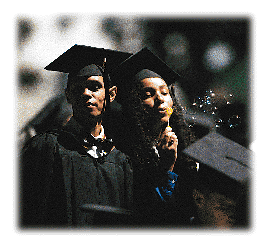
Valedictorian Chan Vee Chong, an electrical engineering major from Singapore,
recalled Princeton's "exacting demands" that resulted in many
a sleepless night working on papers and projects. "At times,"
he said, academic life "can be downright painful." But out of
the strain, Chong said, he found two heroes -- Norman R. Augustine '57 *59,
a lecturer with the rank of professor in mechanical and aerospace engineering,
and Ed Zschau '61, a visiting professor in the electrical engineering department
in 1997-98 -- whose two courses, Engineering the Leader and High-Tech Entrepreneurship,
"changed my life." Echoing Zschau's overarching goal, "to
live a life that matters," Chong called on his classmates to apply
their gifts "for the benefit of the world."
 In his address to the graduates, President Shapiro looked back at the
unprecedented inventiveness and the disappointments of the 20th century:
"In the midst of so much human creativity and achievement we witnessed
senseless cruelty, irrational hatred, insidious oppression, and armed conflict."
To a generation raised in a society "mesmerized by speed and by change,"
he cautioned the graduates to concern themselves more with where they are
headed than with the speed with which they are moving. Many of the issues
that we will face in the next century, said Shapiro, will be older, still
unresolved issues such as how to nourish the world's children. These kinds
of problems, he added, will not be resolved by "one more scientific
discovery." To help address such problems and move toward a more humane
society, he urged graduates to build bridges of "mutual affection,
mutual respect, and mutual responsibility for each other."
In his address to the graduates, President Shapiro looked back at the
unprecedented inventiveness and the disappointments of the 20th century:
"In the midst of so much human creativity and achievement we witnessed
senseless cruelty, irrational hatred, insidious oppression, and armed conflict."
To a generation raised in a society "mesmerized by speed and by change,"
he cautioned the graduates to concern themselves more with where they are
headed than with the speed with which they are moving. Many of the issues
that we will face in the next century, said Shapiro, will be older, still
unresolved issues such as how to nourish the world's children. These kinds
of problems, he added, will not be resolved by "one more scientific
discovery." To help address such problems and move toward a more humane
society, he urged graduates to build bridges of "mutual affection,
mutual respect, and mutual responsibility for each other."
Dean of the Faculty Joseph H. Taylor presented Distinguished Teaching
Awards to Victor H. Brombert, the Henry Putnam University Professor of Romance
Languages and Literatures and Comparative Literature; John A. McPhee '53,
a lecturer in the Council of the Humanities and Ferris Professor of Journalism;
and Daniel I. Rubenstein, a professor of ecology and evolutionary biology.
David H. Bernstein *83, an assistant professor of civil engineering and
operations research, received the award but was unable to attend Commencement.
 At Class Day ceremonies on May 31, the university presented awards to
seniors for outstanding athletic and academic achievements. The Harold Willis
Dodds *14 Achievement Award, for the senior who best embodies the qualities
of Princeton's 15th president, was given to Woodrow Wilson School major
Will Huen, an Asian-American activist and coordinator of the Big Brother/Big
Sister program at Community House. English major Chi Soo Kim and sociology
major Erin Locklear won the Frederick Douglass Service Award, given for
contributions to racial minorities. Kim was a member of the Standing Committee
on the Status of Women, a student admissions associate, a resident adviser,
and co-chair of the 1997 Asian Pacific American Heritage Month. Locklear
chaired the Third World Center Governance Board and was a member of the
Committee to Improve Minority Recruitment and the Race Relations Working
Group.
At Class Day ceremonies on May 31, the university presented awards to
seniors for outstanding athletic and academic achievements. The Harold Willis
Dodds *14 Achievement Award, for the senior who best embodies the qualities
of Princeton's 15th president, was given to Woodrow Wilson School major
Will Huen, an Asian-American activist and coordinator of the Big Brother/Big
Sister program at Community House. English major Chi Soo Kim and sociology
major Erin Locklear won the Frederick Douglass Service Award, given for
contributions to racial minorities. Kim was a member of the Standing Committee
on the Status of Women, a student admissions associate, a resident adviser,
and co-chair of the 1997 Asian Pacific American Heritage Month. Locklear
chaired the Third World Center Governance Board and was a member of the
Committee to Improve Minority Recruitment and the Race Relations Working
Group.
Kelly Fuksa won the Allen Macy Dulles '51 Award, which honors the senior
whose activities "best represent or exemplify Princeton in the nation's
service and in the service of all nations." A chemistry major, Fuksa
was chair of the board of directors of the Student Volunteers Council. She
has worked in a woman's shelter and with runaway teens and abused and neglected
toddlers. The Class of 1901 Medal, for the senior who has done the most
for Princeton, went to David Ascher, a Woodrow Wilson School major who had
been president of the Undergraduate Student Government and student cochair
of the Committee on the Course of Study. He also worked to promote adoption
of a more generous financial-aid policy by the Committee on Undergraduate
Admissions and Financial Aid.
The W. Sanderson Detwiler '03 Prize, for the senior who has done the
most for the class, went to politics major Grace Maa, who was the class
president for two years and who chaired the Honor Committee. She also helped
to develop initiatives to combat alcohol abuse. Kate Gwon, a history major
who has worked on many projects with the SVC, and Jaffet Ghebretnsae, a
molecular biology major and Community House volunteer, won the Priscilla
Glickman '92 Memorial Prize, which recognizes community service.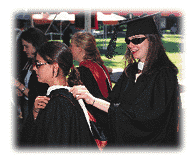
The C. Otto von Kienbusch '06 Sportswoman of the Year Award was shared
by Kirsty Hale, a psychology major who is Princeton's career leader in field-hockey
goals, and Caitlin Rich, an ecology and evolutionary biology major who captained
the women's fencing team for three years. The William Winston Roper '02
Trophy, the highest honor for a male athlete, was shared by basketball player
Brian Earl, football and baseball player Matt Evans, and hockey player Jeff
Halpern. All three majored in economics. Alex Sierk, a molecular biology
major and place-kicker for the football team, won the Class of 1916 Cup
as the varsity-letter-winner with the highest academic standing.
At the Baccalaureate address, delivered on May 30, Marian Wright Edelman,
president of the Children's Defense Fund, described the social and spiritual
disintegration of our society. As a society, she said, we have failed so
many of our most vulnerable citizens. From 1979 to 1996, noted Edelman,
over 75,000 children were killed by guns on America's "killing fields."
"What has happened to us?" asked Edelman, who called on adults
to reach out as tutors and mentors to children; to regulate guns; to encourage
nonviolence and affirm love in our relationships; to accept responsibility
to parent and protect children; to mount a massive moral effort against
poverty, neglect, and intolerance; and to spend more time on children than
on careers.
-- Kathryn Federici Greenwood
Honorary degree recipients
Kofi Annan: Doctor of Laws
Secretary-General of the United Nations
Appointed the seventh secretary-general of the United Nations in January
1997, Kofi Annan is the first secretary-general from sub-Saharan Africa
and the first to rise from UN ranks. He has served that organization for
three decades in a series of key positions in international crisis resolution
and administration, including special representative of the secretary-general
to the former Yugoslavia in 1996; under-secretary-general for peacekeeping
operations from 1993-1996; and assignments in Addis Ababa, Geneva, and UN
Headquarters in New York. During his tenure as secretary-general, Annan
has worked to restructure the UN to provide the organization with greater
flexibility and efficiency.
Oscar Arias Sánchez: Doctor of Laws
Former president of Costa Rica
The 1987 Nobel peace laureate, Oscar Arias Sánchez served as president
of Costa Rica from 1986 to 1990. He began his career as a faculty member
in political science at the University of Costa Rica. He was appointed Costa
Rica's minister of planning and economic policy in the early 1970s and was
elected president in 1986. His election coincided with a period of great
regional discord: the Sandinista regime in Nicaragua was a source of contention
in Central America; civil war was raging in Guatemala; aggravated internal
unrest continued in El Salvador; and border tensions were high between Nicaragua
and its neighboring states of Honduras and Costa Rica. In 1987, Arias drafted
a peace plan that brought greater stability to the region. His efforts were
recognized by the Nobel Peace Prize that year. He used the award's monetary
proceeds to establish the Arias Foundation for Peace and Human Progress,
an organization that he continues to lead and whose mission is to build
just and peaceful societies in Central America.
William J. Baumol: Doctor of Humane Letters
Joseph Douglas Green 1895, Professor of Economics, Emeritus,
Princeton University
An early pioneer of mathematical economics, William Baumol joined Princeton's
faculty in 1949 and served until his retirement in 1992. His research spans
a wide area of interests, from industrial organization and regulation of
industry, to welfare economics, environmental policy, and the economics
of the arts. In each of these areas he has produced major contributions
that have shaped subsequent research. A gifted teacher and writer, and also
an accomplished painter and sculptor, he complemented his courses in economic
theory with a course in wood carving that he gave under the auspices of
the visual arts program.
Phyllis Lambert: Doctor of Fine Arts
Architect, scholar, curator
In 1979, Phyllis Lambert founded the Centre Canadien d'Architecture/Canadian
Centre for Architecture in Montreal. Under her direction, it has become
the preeminent architectural research center and museum, fostering the understanding
of architectural ideas through advanced research, public exhibitions, and
scholarly publications. At the beginning of her career she was instrumental
in bringing a new vision of architecture and urbanism to New York City by
sponsoring Mies van der Rohe for the design of the Seagram Building. Before
there was any organized movement for historic preservation of the built
environment, she put immense personal effort into saving the Old City of
Montreal. She has taken a leadership role in such wide-ranging projects
as the restoration of the biblical Ben Ezra Synagogue in Cairo and the Biltmore
Hotel in Los Angeles, and has established the first international prize
competition for the design of cities. She has been a member of the Advisory
Council of Princeton's School of Architecture.
Harvey Lichtenstein: Doctor of Fine Arts
President and executive producer of the Brooklyn Academy of Music
This summer Harvey Lichtenstein will step down as president and executive
producer of the Brooklyn Academy of Music (BAM), America's oldest performing
arts center. When he assumed leadership of BAM in 1967, he shifted its focus
to the new generation of artists who were not receiving support elsewhere.
Early in his career, BAM was the site of the New York premiere of Alban
Berg's Lulu. The 1970s saw Peter Brook's landmark production of A
Midsummer Night's Dream, and the introduction of minimalist composer
Steve Reich. In 1983, Lichtenstein established the Next Wave Festival, which
has gained recognition as the largest and most influential exposition of
contemporary performing arts in the United States. Productions include Philip
Glass's and Robert Wilson's Einstein at the Beach. Most recently
BAM opened film theaters for the presentation of independent and foreign
film.
Gordon Parks: Doctor of Fine Arts
Photojournalist
Best known as a photojournalist, Gordon Parks has mastered many artistic
media. He began his career as a photographer in President Franklin D. Roosevelt's
Farm Security Administration. He was the first African-American photographer
for Vogue magazine as well as for Life magazine, where he
worked from 1949 until 1968. While with Life, he completed over 300
assignments and articles on subjects that ranged from the segregation of
the South to the poverty of the slums of Brazil, from royalty and movie
stars to sharecroppers and Black Panthers. He documented and participated
in the civil-rights struggles of the 1960s; founded Essence magazine;
wrote poetry and several autobiographical novels, including, most recently,
Voices in the Mirror; and directed six films. His work has been exhibited
in major museums and galleries throughout the country and was recently the
subject of a retrospective at the Corcoran Gallery of Art in Washington,
D.C.
Harold Varmus: Doctor of Science
Director of the National Institutes of Health
Harold Varmus has been the director of the National Institutes of Health
(NIH) since November 1993. Previously he was professor of microbiology,
biochemistry, and biophysics at the University of California, San Francisco,
where he joined the faculty in 1970. Varmus shared the 1989 Nobel Prize
in Physiology or Medicine for demonstrating that cancer genes (oncogenes)
can arise from normal cellular genes. This discovery marked the beginning
of the era of molecular oncology and revolutionized the approaches that
were being used to study tumor cell development. As director of the NIH,
Varmus has successfully reinvigorated this federal research agency and has
increased both its stature and its scope. According to his citation, "he
has challenged the scientific community to think creatively about the present
and boldly about the future."
GO TO
the Table of Contents of the current issue
GO TO PAW's
home page
paw@princeton.edu
 This year some 7,800 alumni, the largest
recorded number ever to return for Reunions, burst upon the campus the weekend
of May 29. Counting family members, the throng totaled an estimated 15,000.
Former classmates gathered in lecture halls where they once scribbled notes,
caught up on who's doing what, and discreetly compared expanding waistlines
and receding hairlines. They dressed in all combinations of orange and black.
Women donned tiger earrings and orange scarves. Men wore tiger-skinned baseball
caps, orange-and-black striped socks, and orange ties. A new -- and controversial
-- addition to everyone's uniform were orange hospital-type wristbands to
control access to parties.
This year some 7,800 alumni, the largest
recorded number ever to return for Reunions, burst upon the campus the weekend
of May 29. Counting family members, the throng totaled an estimated 15,000.
Former classmates gathered in lecture halls where they once scribbled notes,
caught up on who's doing what, and discreetly compared expanding waistlines
and receding hairlines. They dressed in all combinations of orange and black.
Women donned tiger earrings and orange scarves. Men wore tiger-skinned baseball
caps, orange-and-black striped socks, and orange ties. A new -- and controversial
-- addition to everyone's uniform were orange hospital-type wristbands to
control access to parties.
 at a presentation of a video on George Washington. The
presidential hopeful made brief remarks.
at a presentation of a video on George Washington. The
presidential hopeful made brief remarks.
 Saturday morning in McCormick 101, alumni debated whether Princeton
was a jock school. Celia A. Herron '74, who was the university's first female
diver in the early days of coeducation, said, "Yes! And we should be
darn proud of it. Diving gave me a niche." B. Peter Carry '64, the
executive editor of Sports Illustrated, worried that, due to the
high level at which Princeton's teams compete, it has to recruit an "unduly"
large percentage of every incoming class as athletes. This situation, he
said, affects the admission process and the composition of the student body.
Saturday morning in McCormick 101, alumni debated whether Princeton
was a jock school. Celia A. Herron '74, who was the university's first female
diver in the early days of coeducation, said, "Yes! And we should be
darn proud of it. Diving gave me a niche." B. Peter Carry '64, the
executive editor of Sports Illustrated, worried that, due to the
high level at which Princeton's teams compete, it has to recruit an "unduly"
large percentage of every incoming class as athletes. This situation, he
said, affects the admission process and the composition of the student body. On Saturday afternoon, the Allentown High School marching band, courtesy
of the Class of 1949, snaked through the crowd in front of Nassau Hall as
musicians warmed up and alumni waited for the 2 p.m. start of the P-rade.
Many appeared slightly wilted in the heat, and some carried water bottles.
To the tune of "Going Back," the Princeton band started the procession,
followed by the 25th-reunion Class of 1974, whose theme was "Stars
in Stripes." Class members clutched silver, star-shaped balloons and
celebrated some of their more notorious activities on placards held aloft:
"popping pills, smoking joints" and "Nude Olympics begins."
Following in their wake were members of the Old Guard, led by W. Harding
Kneedler '22, who carried the Class of 1923 cane as the oldest member of
the oldest class returning to Reunions.
On Saturday afternoon, the Allentown High School marching band, courtesy
of the Class of 1949, snaked through the crowd in front of Nassau Hall as
musicians warmed up and alumni waited for the 2 p.m. start of the P-rade.
Many appeared slightly wilted in the heat, and some carried water bottles.
To the tune of "Going Back," the Princeton band started the procession,
followed by the 25th-reunion Class of 1974, whose theme was "Stars
in Stripes." Class members clutched silver, star-shaped balloons and
celebrated some of their more notorious activities on placards held aloft:
"popping pills, smoking joints" and "Nude Olympics begins."
Following in their wake were members of the Old Guard, led by W. Harding
Kneedler '22, who carried the Class of 1923 cane as the oldest member of
the oldest class returning to Reunions. The Allentown marching band heralded the 50th-reunion Class of 1949,
which celebrated events of the century, some good ("1937 -- Golden
Gate Bridge") and some bad ("1974 -- hot pants") on numerous
placards. The 45th-reunion Class of 1954 carried Japanese lanterns and earned
loud applause for its uniform: Japanese happi coats with a growling
tiger on the back and the class numbers in Japanese characters on the lapel.
The Allentown marching band heralded the 50th-reunion Class of 1949,
which celebrated events of the century, some good ("1937 -- Golden
Gate Bridge") and some bad ("1974 -- hot pants") on numerous
placards. The 45th-reunion Class of 1954 carried Japanese lanterns and earned
loud applause for its uniform: Japanese happi coats with a growling
tiger on the back and the class numbers in Japanese characters on the lapel.
 BOOGIE NIGHT
BOOGIE NIGHT Princeton's 252nd commencement ceremony on June 1, was like no other
for two graduating seniors. Not only did Anastacia M. Rohrman receive her
B.S., but she also was asked for her hand in marriage by classics major
Thomas W. Schmidt, who near the end of his Latin salutatory address switched
into English, without missing a beat, and asked her, "Will you marry
me?" A stunned Rohrman could only cry and hold up a sign reading "Yes!"
on both sides which one of Schmidt's friends shoved into her hands.
Princeton's 252nd commencement ceremony on June 1, was like no other
for two graduating seniors. Not only did Anastacia M. Rohrman receive her
B.S., but she also was asked for her hand in marriage by classics major
Thomas W. Schmidt, who near the end of his Latin salutatory address switched
into English, without missing a beat, and asked her, "Will you marry
me?" A stunned Rohrman could only cry and hold up a sign reading "Yes!"
on both sides which one of Schmidt's friends shoved into her hands.
 In his address to the graduates, President Shapiro looked back at the
unprecedented inventiveness and the disappointments of the 20th century:
"In the midst of so much human creativity and achievement we witnessed
senseless cruelty, irrational hatred, insidious oppression, and armed conflict."
To a generation raised in a society "mesmerized by speed and by change,"
he cautioned the graduates to concern themselves more with where they are
headed than with the speed with which they are moving. Many of the issues
that we will face in the next century, said Shapiro, will be older, still
unresolved issues such as how to nourish the world's children. These kinds
of problems, he added, will not be resolved by "one more scientific
discovery." To help address such problems and move toward a more humane
society, he urged graduates to build bridges of "mutual affection,
mutual respect, and mutual responsibility for each other."
In his address to the graduates, President Shapiro looked back at the
unprecedented inventiveness and the disappointments of the 20th century:
"In the midst of so much human creativity and achievement we witnessed
senseless cruelty, irrational hatred, insidious oppression, and armed conflict."
To a generation raised in a society "mesmerized by speed and by change,"
he cautioned the graduates to concern themselves more with where they are
headed than with the speed with which they are moving. Many of the issues
that we will face in the next century, said Shapiro, will be older, still
unresolved issues such as how to nourish the world's children. These kinds
of problems, he added, will not be resolved by "one more scientific
discovery." To help address such problems and move toward a more humane
society, he urged graduates to build bridges of "mutual affection,
mutual respect, and mutual responsibility for each other." At Class Day ceremonies on May 31, the university presented awards to
seniors for outstanding athletic and academic achievements. The Harold Willis
Dodds *14 Achievement Award, for the senior who best embodies the qualities
of Princeton's 15th president, was given to Woodrow Wilson School major
Will Huen, an Asian-American activist and coordinator of the Big Brother/Big
Sister program at Community House. English major Chi Soo Kim and sociology
major Erin Locklear won the Frederick Douglass Service Award, given for
contributions to racial minorities. Kim was a member of the Standing Committee
on the Status of Women, a student admissions associate, a resident adviser,
and co-chair of the 1997 Asian Pacific American Heritage Month. Locklear
chaired the Third World Center Governance Board and was a member of the
Committee to Improve Minority Recruitment and the Race Relations Working
Group.
At Class Day ceremonies on May 31, the university presented awards to
seniors for outstanding athletic and academic achievements. The Harold Willis
Dodds *14 Achievement Award, for the senior who best embodies the qualities
of Princeton's 15th president, was given to Woodrow Wilson School major
Will Huen, an Asian-American activist and coordinator of the Big Brother/Big
Sister program at Community House. English major Chi Soo Kim and sociology
major Erin Locklear won the Frederick Douglass Service Award, given for
contributions to racial minorities. Kim was a member of the Standing Committee
on the Status of Women, a student admissions associate, a resident adviser,
and co-chair of the 1997 Asian Pacific American Heritage Month. Locklear
chaired the Third World Center Governance Board and was a member of the
Committee to Improve Minority Recruitment and the Race Relations Working
Group.